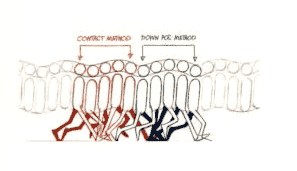A "walk cycle" is an animated loop that we produce describing all the phases of walking, from one extended position to another,
and then back to the exact same extended first pose.
If you begin the cycle with right foot ahead and the left arm behind ,it will follow the main poses until the left foot is
placed ahead in the next extension, and then analyze all the other poses until we come back to
the first-right foot ahead position.
A walk cycle is usually produced with 5 to 8 poses per step, that means 10 to 16 poses per cycle.
Notice that the arms produce exactly the opposite swing in order to maintain balance through the de-stabilizing operation of
walking (throwing the body forwards on mid air).
Try to walk in very slow motion and memorizing each one of the key poses and you will see how difficult is to keep balance
through
the process.
The single most important frame of a walk-cycle is the contact pose_ the only one of all keyframes where
the 2 feet are touching the floor.
The feet are at their furthest extension in the walk. That is their most extreme position in the cycle.
The head is at its lowest position if your character is describing a very wide step.
This should be the first pose that you draw .
When the right foot is forward, the right arm is back, and vice versa. This is called "counterpose".
This is how nature keeps everything in balance when you move: one side of the body "opposes" the other.


Now look at the recoil pose, the second main pose in the cycle.
This is the frame where the character fully impacts the ground. It can also be the lowest point in the cycle.
The front foot is fully in contact with the ground; the rear foot has just lifted up from it.
Note that the leading foot is directly beneath the body, supporting the weight above it.
The character's body is stretched to the maximum as he lifts his leading leg forward to reach the next contact position.
The heel of the trailing foot is just beginning to leave the ground.
The arms are both at its closest position to the body (at the center of their pendulum swing.